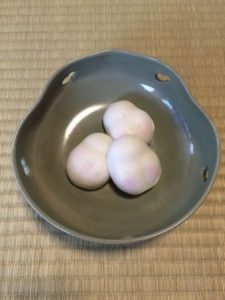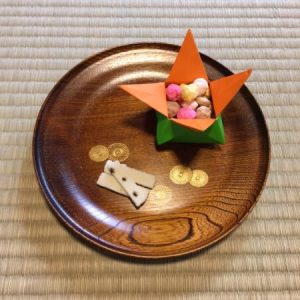Setsubun Tea Ceremony in February 3rd. You can do it at home!
Tea Ceremony for Setsubun in February
Setsubun means the division of seasons, or the end of winter on the lunar calendar. It is the tradition to eat sardines and throw roasted soybeans at demons on February 3rd. When I was young, I remember throwing beans at demons in kindergarten, or when I threw soybeans at my father, who pretended to be the devil by wearing the devil mask outside the house. Throwing soybeans at demons to ward off evil for the new year, and cleanse away any disease-carrying evil spirits from the previous year, has long been an annual tradition.
But when the time of Setsubun Tea Ceremony arrives, we wonder why beans and demons at the end of the winter season? I’d like to research the origin of this strange tradition and learn where it has originated from.
The Origin of Setsubun on February 3rd. It is for Warding Off Evil.
The origin goes back to Heian period (794-1192). There was an event called, “Tsuina” to ward off evil spirits in the imperial palace on the New Year’s Eve.
There was a special leader position to ward off evil spirits, called “Ho-so-shi” in the palace. After him, the noble men shot bow and arrows toward the evil spirits.
This event disappeared in Muromachi period (1336-1573) and was changed to throwing roasted soybeans at the evil spirits.
Why is it roasted beans? It is said that it must be roasted, because any fresh beans left on the ground uncollected after the festival might put forth buds. If the beans sprout, it means that we have failed to ward off the evil spirits.
In addition, we have sardines and decorative hollies, which are disliked
by the devils. I guess it’s because of the strong smell of the fish and the
thorns of hollies that help keep the devils away. We often think strong
smells are effective to protect people from evil spirits.
Setsubun events in Kyoto
There are many Setsubun events that take place in shrines and temples in Kyoto. I think the most famous one is in Yoshida shrine. It holds a large festival from February 2-4th. We can see the reproduction of “Tsuina” from Heian period on February 2nd. It’s also fun to walk through the many street booths in Yoshida shrine.
Yoshida shrine
〒606-8311 30 Kaguraoka-cho Yoshida Sakyo-ku Kyoto
TEL 075-771-3788
Feb. 2nd 8am Setsubun eve
6pm The reproduction of Tsuina event
Feb.3rd 8am Setsubun festival
URL: http://www.yoshidajinja.com/setubunsai.htm
Talking about the Tea Ceremony for Setsubun festival, the most famous one is in Tenryuji temple in Sagano, Kyoto. It is one of the world heritage sites.
They have a bean throwing event 3 times a day (11:30~, 13:30~, 15:30~).
There is an event in Tenryuji, called “Shichifukujin meguri”, where you can collect 7 lucky papers and tie them onto small bamboo branches. You will visit 7 sub-temples in Tenryuji. It is considered a lucky item to have if you decorate the bamboo in important places in your house.
Daihonzan Tenryuji temple
〒616-8385 68 Susukino Baba-cho Tenryuji Saga Ukyo-ku Kyoto
Please take the City Bus #28 and get off at “Arashiyama Tenryuji Mae”
TEL:075-881-1235(8:30 〜 17:30)
URL:http://www.tenryuji.com/event/index.html
Setsubun Tea Ceremony at Home !
The hanging scroll is the painting of a devil created by Matsuzan Takahoshi. He is the artist of “Otsue”, the traditional paintings of Shiga prefecture. Otsu is the prefectural capital of Shiga prefecture, next to Kyoto prefecture. Otsu paintings have been painted since 1624-43, during the Edo period. Varieties of Buddhism gods like Amida, Jizo, etc. were painted, which were popular in the beginning among the poorer people. Later on, not only Buddhist gods, but caricatures of people living there were created.
To give a more heartwarming feel, the demons, “Oni” that were supposedly scary looking are being depicted with some more charm.
This flower is a white camellia in a Bizen pottery. If your room is a one-room apartment, I think small vase for one flower is nice.
The main sweets are “Okame manju”, which is associated with the Setsubun festival. Okame resembles a woman’s face. It is thought that a face with light pink, plump cheeks is a symbol of happiness.
In addition, 5 colored roasted sweet beans in an origami box is served. Paper folding this box with children can be a fun family activity.
At last, powdered green tea in a tea bowl of white plum flowers is served. Beautiful plum flowers have begun blooming the garden of Kitano Tenmangu shrine in Kyoto.
How About Some Sweets Made of Beans as Souvenirs? They Are Popular Among Foreign Visitors!
A special box sweet beans for Setsubun is sold in Mamemasa, a confectionary shop in Kyoto, which makes sweets and snacks made of Japanese soybeans.
It is a box of roasted beans and 5 colored assorted sweet beans. Hearing “sweet beans”, you might think it is a little mysterious, but my guests from foreign countries liked them a lot. The green ones taste like tea, and brown ones have cinnamon.
When you open the box, there is a little gold statue of a happy god as a bonus. It will be effective if we put it in our purse.
We can buy soybean snacks made by Mamemasa at Kinkakuji Temple,
which is just a 1 minute walk from Tea Ceremony Koto.
Suhama dumplings (3 color dumplings) have also been popular sweets since my mother’s generations. My foreign guests also liked this dumplings made of beans and syrups.
I know foreigners don’t necessarily like the sweets that a lot of Japanese
people love, but most of my guests from many countries didn’t leave a
single piece of dumpling at the tea ceremony. I recommend you to try the
sweets. It’s a good buy!
for the daily sweets for coffee as well as matcha.
Mamemasa
〒604-0805 264 Mukadeya-cho Yanaginobanba Nishiiru Ebisugawa-dori Nakagyo-ku Kyoto
TEL: 075-211-5211
5 minute walk from Gate 7 of Marutamachi subway station.
URL:http://www.mamemasa.co.jp/store/
















